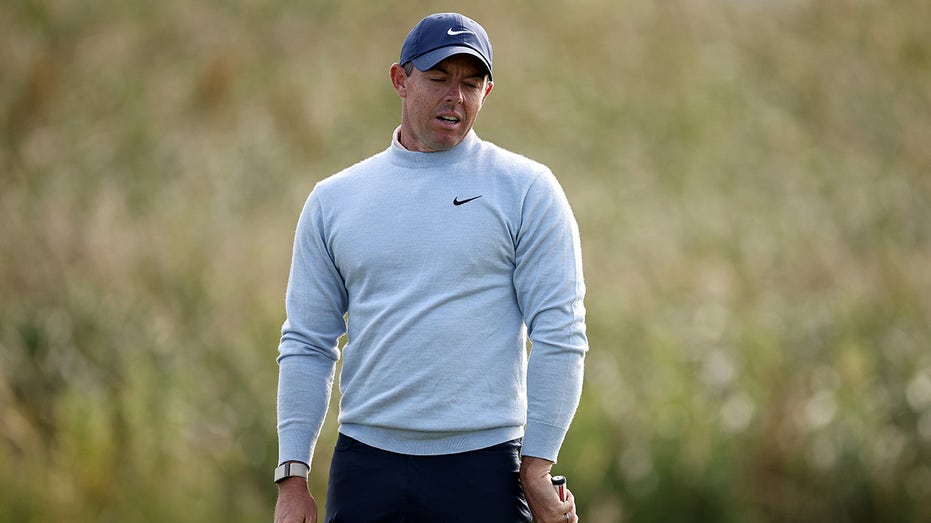You might say Tito Puente was born to connect cultures.
Puente, after all, is the Spanish word for bridge.
The New York City native, born to parents from Puerto Rico, found fame the world over as the Latin King, the Mambo King or, simply, El Rey — the King, in Spanish.
His story is all American.
MEET THE AMERICAN WHO INSPIRED AMERICAN LEGION BASEBALL, JOHN GRIFFITH, WWI VET AND SPORTS PIONEER
Beloved for his multicultural percussion, Afro-Cuban rhythms and crossover compositions, Puente enjoyed acclaim that spanned generations and genres.
The timbale, a set of high-standing drums developed in Cuba in the early 20th century, was his specialty.
"Master drummer, percussionist, pianist, saxophonist, vocalist, composer, orchestrator, arranger and conductor," the Center for Puerto Rican Studies at Hunter College wrote in a 2011 tribute about the favorite son.
"Out of the lengthy list of musicians who have contributed to the development and acceptance of our music throughout the world, none is more recognized than the man known simply as ‘the king.’"
Yet much of his personal story is largely unknown, most notably his service at sea and his survival of one of the most frightening moments in the history of naval warfare.
Teenage Puente joined the U.S. Navy at the outbreak of World War II and fought in battles across the globe.
"He was a proud American," his son, musician Tito Puente Jr., told Fox News Digital.
Puente was buried with the full military honors of a grateful United States in New York State after his death in 2000.
But like many members of the Greatest Generation, he rarely talked about his war service.
Puente had an infectious style of musicianship on stage — a wide smile and a look of joy that permeated his energetic performances.
Said Puente Jr., however, "if you looked closely at his face, you could see the scars from World War II on his face."
Ernest Anthony "Tito" Puente Jr. was born on April 20, 1923, in New York City.
His parents, Ernest Anthony and Ercilla (Ortiz) Puente, reportedly arrived in Manhattan shortly before their famous son was born.
Puente’s father provided for his wife and children by working at a razor factory in Brooklyn.
The family lived at the corner of East 110th Street and Madison Avenue, according to Puente Jr., just a block from Central Park, in Spanish Harlem.
Puente was a musical prodigy. He learned the piano at age 7, turned professional at age 13 and played over a dozen instruments.
"He got his first big break as a professional playing with the Machito Orchestra as the drummer in the early 1940s," Zach Smyers of the Hampton Roads Naval Museum wrote earlier this year.
"The Machito Orchestra, formed by Frank ‘Machito’ Grillo in 1939, combined Afro Cuban Jazz with traditional salsa music. The popularity of this hybrid genre continued to grow with fans."
Puente was on the cusp of musical fame.
The world had other ideas.
He was just 18 when Japan launched its surprise attack on Pearl Harbor on Dec. 7, 1941.
He was drafted by the U.S. Navy in 1942 and served aboard the escort carrier USS Santee (CVE-29) until the end of the war.
He was a shipboard musician and bugler. "He's the one who played taps," said Puente Jr.
But like every sailor, he was trained to fight at sea.
He had plenty of opportunity aboard the Santee. The ship earned nine battle stars, from the invasion of North Africa in 1942 to the invasion of Okinawa in 1945.
"He never told us about it," said Puente Jr.
There is likely one day that his dad never forgot, even if he never shared the story.
The date Oct. 25, 1944, is heroic in military lore — it's known as St. Crispin's Day.
The Battle of Agincourt was fought on St. Crispin's Day in 1415. King Henry V, according to Shakespearean drama, delivered his famous "Band of Brothers" speech before defeating the French that day.
"From this day to the ending of the world/But we in it shall be remember’d/We few, we happy few, we band of brothers/For he today that sheds his blood with me shall be my brother."
"The Charge of the Light Brigade," immortalized by Alfred Lord Tennyson, took place on St. Crispin's Day in 1854.
Japan unleashed a frightening new form of aerial warfare on St. Crispin's Day in 1944. The first kamikaze suicide planes attacked the U.S. Navy that day during the Battle of Leyte Gulf.
The USS Santee was among the first vessels struck by one of the desperate pilots.
The bomb-laden plane crashed into Puente's ship at top speed, tore a hole through the flight deck and exploded in the hangar, sending a fireball high above the carrier.
Four crewmen, four of Santee's band of brothers, were killed in the explosion. An untold number were wounded.
The carrier was struck by a torpedo shortly afterward, causing the massive ship to list six feet.
"I believe it was very traumatic for him," said Puente Jr. "He went from being a professional musician to watching his friends get killed in the war."
Whether wounded during the kamikaze attack or in one of the ship's eight other battles, the musician bore minor shrapnel scars on his face the rest of his life, his son told Fox News Digital.
Two of the musician's three children, Tito and Audrey — the latter a meteorologist with Fox 5 in New York City — received a commendation from the Military Honor of the Purple Heart in their dad's honor in 2018.
Puente Jr. never knew the details.
"I guess he got home and just wanted to hone in on music and composition," the son said. "It's fortunate that his amazing talent survived the tragedy of nine battles."
Puente indeed returned to music after the war, with an assist from Uncle Sam in honor of his service.
He attended New York City’s world-famous Juilliard School on the G.I. Bill and by the 1950s had emerged as a pioneering hitmaker of a hot new postwar American soundtrack.
Latin music, flavors, cocktails and culture swept the nation, with Puente providing its most popular rhythms.
"Fans enjoyed the way Puente put a big band spin on traditional Latin dances, mixing Latin sounds with jazz and other genres," according to Biography.com.
"Puente later added other Latin and Afro-Cuban rhythms to his repertoire, including cha-cha, merengue, bossa nova and salsa, and his continuous experimentation and creativity earned him a reputation as a musical pioneer."
He wrote and recorded his signature hit, "Oye Como Va," in 1962.
A modernized version of a traditional cha-cha, his "Oye Como Va" was essentially a Latin and pop crossover hit and a live performance favorite. It's now recognized as a standard of American music.
"Few songs have embraced so much of the Latin American spirit in popular music as ‘Oye Como Va,’" Grammy.com reported in a review of the tune.
It became a worldwide smash for Mexican-American guitar prodigy Carlos Santana in 1970, who recorded and released it soon after his breakout performance at Woodstock.
"Santana’s version of ‘Oye Como Va’ … introduced Puente to a much larger audience," music editor Matt Micucci wrote for Jazziz.com in 2017.
"As a result, Puente reintroduced the song in his repertoire. Furthermore, ‘el Rey’ began to get booked again at a difficult time when he had been struggling to keep his big band."
The huge hit for Santana also provided a windfall of royalties for the songwriter, who by then was pushing 50 — a dinosaur age (back then) with a big-band history in a world that had embraced pop and rock music.
Yet Puente's music still connected with a new generation of fans.
Puente misread a royalty check soon after Santana's "Oye Como Va" became a hit, according to one tale.
He thought it was for $35. Instead, it was a check for $35,000.
"Everybody's heard of Santana. Santana! Beautiful Santana!" Puente beamed later. "He put our music, Latin rock, around the world, man!"
MEET THE AMERICAN WHO FIRST RECORDED THE BLUES, NATION'S ORIGINAL POP DIVA MAMIE SMITH
The song continues to captivate global musicians and audiences.
Santana re-recorded a version of the Puente tune in 2022 featuring 20 musicians from around the world.
"‘Oye Como Va’ has endured the test of time and continues to bring people together to dance and sing together, around the world," Puente Jr. told Rolling Stone magazine last year.
Ernest Anthony "Tito" Puente Jr. died in a New York City hospital after he suffered heart trouble on May 31, 2000. His family was by his side.
He was 77 years old.
The "popular bandleader" was "adored by fans across the globe" and "several supporters waited in line for days to say goodbye" to him, wrote Biography.com of the vigil outside the hospital.
He’s buried at St. Anthony’s Church Cemetery in Nanuet, New York.
"I can tell you that it's just a sad day, a sad day for the Latin music industry," Eddie Rodriguez, Puente's manager, told media outlets in the hours that followed the musician's death.
"Tito was known all over the world."
His success in music earned his children a lifestyle not known by the previous generation. He raised his children on the Upper West Side, not far from Lincoln Center, Manhattan’s sprawling entertainment complex, and his alma mater, The Juilliard School.
"We were the Puerto Rican Jeffersons," joked Puente Jr.
In 1997, Puente had released a 50-song multi-CD compendium of his greatest works — and shortly before his death he recorded his 120th album.
CLICK HERE TO SIGN UP FOR OUR LIFESTYLE NEWSLETTER
He received the National Medal of Arts from President Bill Clinton in 1997 and was honored by the Library of Congress as a "living legend" before his passing in 2000.
East 110th Street in Spanish Harlem, his childhood home, has since been dubbed Tito Puente Way.
A huge mural of Puente playing timbale brightens the corner of Puente Way at Third Aveneue.
Puente is celebrated with a star on the Hollywood Walk of Fame.
He received six Grammy Awards, including a posthumous Lifetime Achievement Award in 2003.
He played live for several presidents, his music provided beats for movie soundtracks and he starred, most notably, as himself in the 1992 movie "The Mambo King."
He even had a recurring role as himself on "The Simpsons."
Puente was "the most influential artist in the development of Latin American music in the United States in the 20th century," biographer Steven Loza wrote in "Tito Puente and the Making of Latin Music," noting the artist’s "overwhelming" body of work.
"It is clear that Tito Puente ranks with the Ellingtons and the Beethovens — or, as those artists might put it, they rank with him."
To read more stories in this unique "Meet the American Who…" series from Fox News Digital, click here.



